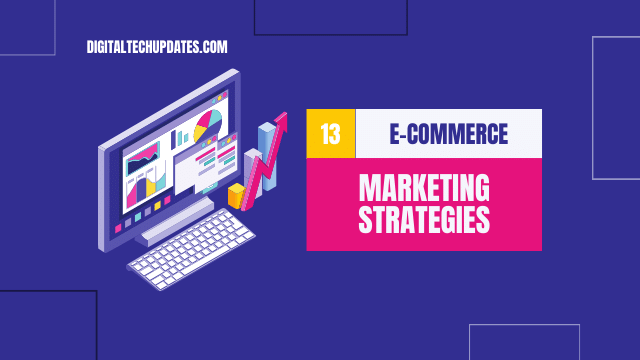If you’re a digital marketer, you’ve likely heard that e-commerce marketing is the next big thing. And it’s true: e-commerce marketing is the next big thing if you want to boost your site’s revenue and conversions. This excites digital marketers because it combines two of the internet’s favorite things: shopping and social media. But there’s a catch: promoting your business effectively across many media also necessitates a significant time and effort investment. It can be difficult to tell which strategies will produce results and get people enthusiastic about buying from your company because there are so many ways for brands to communicate with customers online. That’s why we’ve rounded up 13 proven strategies for e-commerce marketing success below!
1. Create a WordPress Website.
WordPress is a free, open-source platform that makes creating a website or blog a breeze. WordPress is so popular that it runs more than 60 million websites —and because it’s an open-source platform with a vibrant community, you can be sure that there will be plenty of developers willing to assist you if you run into any issues.
WordPress has a built-in function for search engine optimization (SEO), meaning it will automatically make your site friendly to search engines like Google and Bing. And since the platform was created by developers, it also comes with plenty of features that make managing your site much easier than many other content management systems out there.
2. Use Product Pages for Marketing Content.
When it comes to your e-commerce website, product pages are the most critical pages. Search engines and conversions should be optimized for product pages, which implies lots of material.
Product Page Search Engine Optimization (PPC)
Create unique meta descriptions and titles, include them in sitemaps and images, use keywords in URLs and alt attributes, embed schema data throughout your product description (especially if it’s long), add links to related products from within descriptions or at the bottom of each page (if possible), and so on to optimize your product pages. These methods will assist Google in properly indexing your items so that they appear in search results when consumers search for certain terms relevant to your products or services!
Conversion Optimization for Product Pages
In order to drive conversions on ecommerce sites, there has been tons of research done around how many features/options should be available on a particular product detail page versus not having enough info available about what makes those options different from one another-which could lead someone who wasn’t ready yet to make an impulse buy instead of leaving without purchasing anything at all! This is because there’s just too much information thrown out there without explaining why these choices matter.
3. Engage Your Customers Through Email Campaigns.
Email marketing is a powerful tool for increasing sales. Email marketing has the greatest open rate of all online channels, with an average of 23% compared to 13% for social media, according to Statistica. It also has a good conversion rate and a good click-through rate (CTR). According to the 2016 MailChimp Email Marketing Benchmark Report,
- Email sent has a 98% delivery guarantee.
- 98% of emails are opened on mobile devices.
- The lifetime value (LTV) per subscriber is $2.61.
4. Build credibility with testimonials.
Social proof in the form of testimonials is very effective. They can provide your clients with the assurance they need to buy from you and generate brand loyalty.
However, testimonies must be handled with caution. Keep your testimonials brief and on-brand, rather than incorporating irrelevant details or making them excessively long, to avoid appearing boastful.
Take a look at how Coffee & Quinoa incorporates customer service into their marketing strategy:
- They incorporate customer service into the product description itself, which makes it easy for potential customers to see why Coffee & Quinoa stands out from other brands in this category (the word “delightful” is used twice).
- The company uses the word “delightful” again later in their copy (“our delightful coffee”) because it’s important for them to emphasize how much enjoyment you’ll get out of purchasing from them versus someone else.
5. SEO-Optimize Your Website.
Search Engine Optimization (SEO) refers to a technique for enhancing traffic to websites by utilizing search engine results. It increases your site’s visibility. Potential customers are more likely to find your website and become customers if they search for terms associated with your brand.
You can apply the following procedures to SEO optimize your website:
- Create a sitemap.
- Use keywords in your content.
- Use alt tags.
- Use keywords in your title tag, meta description, and URL.
- Create a linkable website
E-commerce and social media go hand in hand.
The use of social media platforms by marketers to connect with ecommerce customers is nothing new. Online shopping and brand research via social media are on the rise, and for good reason.
Sales can be boosted by using social media. You may use social media to communicate with customers, drive traffic to your website, and increase brand awareness, community, and followers.
7. Create Convertible Ads.
You’ve got that great product, but if you don’t have the right ad to go with it, you’re not going to have much luck getting the sale. Here are some tips for making sure your ads work:
- Make them applicable. Your advertisements cannot be generic or unhelpful; they must speak specifically to your target audience and provide them with the information they require to make a decision. You should also consider where they’re seeing your ad—if it’s on Facebook or Google, take advantage of things like dynamic remarketing lists (which you can use even if you don’t have an ecommerce business). If possible, use retargeting technology, which allows you to show advertisements to individuals who visit specific pages of your website but don’t buy anything yet (retargeting is typically reserved for larger organizations with dedicated budgets, but that doesn’t mean small businesses can’t put up campaigns).
- Keep them simple and straightforward. Instead of using technical jargon, use plain English; if possible, include links back to their website where further information about the products or services being sold can be found (for example, instead of offering $5 wine bottles, offer “5 dollar wine bottles,” which could include solely reds). Customers will know exactly what they’re getting before clicking through, avoiding any unpleasant surprises when it comes time to accept payments! Finally, choose your photographs carefully because buyers typically base their purchasing decisions solely on what they see here the first time around—so make sure everything appears professional enough before moving on to the next step.
8. Feature a Blog on Your Ecommerce Site.
One of the most successful strategies to generate sales is to have a blog on your e-commerce site. Blogs are also an excellent way to raise brand awareness and drive traffic to your store.
Here are some pointers for starting, promoting, and using a blog:
- Make relevant material for your industry or niche. Write about product reviews, how-to tutorials, and other topics! These postings will be useful to your readers as they try new goods or solve problems in their daily lives. Make sure you’re providing new material on a regular basis that connects to what customers want while also remaining loyal to your brand’s identity (for example, if you sell pet supplies online, don’t write about fashion trends).
- Promote it as much as possible! It doesn’t matter how much effort you put into developing content if no one reads it (or worse yet, no one even knows it exists). Ensure that your blog article has several links directing back to its landing page(s) across multiple social media sites, such as Facebook, Instagram, Twitter, and so on, to ensure that it reaches its full potential.
9. Make Use of Video Content (and Include It on Your Website).
Video content is the best way to explain your product or service. It can be used to show how something works or to simply describe what it does for your customers. Consumers are considerably more inclined to buy if they can see a product in action first, so video is a terrific approach to enhance conversion rates.
If you would like more information about how video can help your ecommerce store, please contact us today!
10. Advertise on Social Media Through Visuals and Videos.
You can target specific audiences, demographics, interests, and behaviors withsocial media advertising.
You can use Facebook ads to target the following:
- Age and gender demographics.
- Interests: hobbies, activities or sports related to your brand.
- Those are people who have recently visited your website or purchased something from you.
11. Retarget.
Retargeting allows you to reach customers who have previously visited your website. It’s also a technique of ensuring that your potential customers are aware of the items or services you offer. Retargeting is one of the most effective marketing methods for e-commerce enterprises since it works on both desktop and mobile devices, allowing you to reach out to all potential customers regardless of their location.
Retargeting advertisements operate by serving advertising to users who have previously visited your site based on their previous behavior, even if they were not ready to buy at the time. This strategy means you will be able to tell if someone has left your page without making a purchase, which helps you understand what kind of problems there may be with your product or service. Retargeting allows you to target people who have been interested in buying something but haven’t actually completed the transaction yet. People who see these ads might not remember what they were looking at previously, so they might return once again (this time with intent) and convert into paying customers.
12. Create Amazon-optimized Content.
Publishing Amazon-optimized content is one of the most successful ways to increase traffic and sales through your e-commerce campaign. You’re probably aware that Amazon receives a lot of traffic: the site receives up to 244 million monthly visitors, resulting in over 6 billion page views (source). You also know that they have information on your customers: they can track purchases and reviews, so they know exactly what people are buying from you and how happy they are with it.
You can reach new audiences while also reaching existing ones by using this information to generate content on Amazon pages, such as product descriptions or user instructions.
When people come across a well-written piece of content on an Amazon page, there’s nothing stopping them from following links back to your website—and there won’t be any barriers preventing them from becoming repeat customers!
13. Add these methods to your ecommerce marketing strategy.
Here’s a list of some additional strategies to drive sales through e-commerce marketing:
- Display product ratings and reviews prominently on your site.
- Include a prominent search box on every page of your website, including category pages and product detail pages.
- Create effective CTAs for all key pages on your site (such as homepages, category pages, product detail pages) that get visitors to convert into customers.
- Use relevant keywords in titles and meta descriptions that match or closely relate to those keywords used by users searching for products like yours.
Conclusion
You can use e-commerce marketing to steer your customers in just the right direction. However, you must be able to separate yourself from the pack, like with any business model. Because there are so many companies doing similar things, it comes down to who can give the best customer experience and develop brand recognition in interesting ways. One of these methods is ecommerce marketing. If you can do it successfully, your company will prosper for many years.




